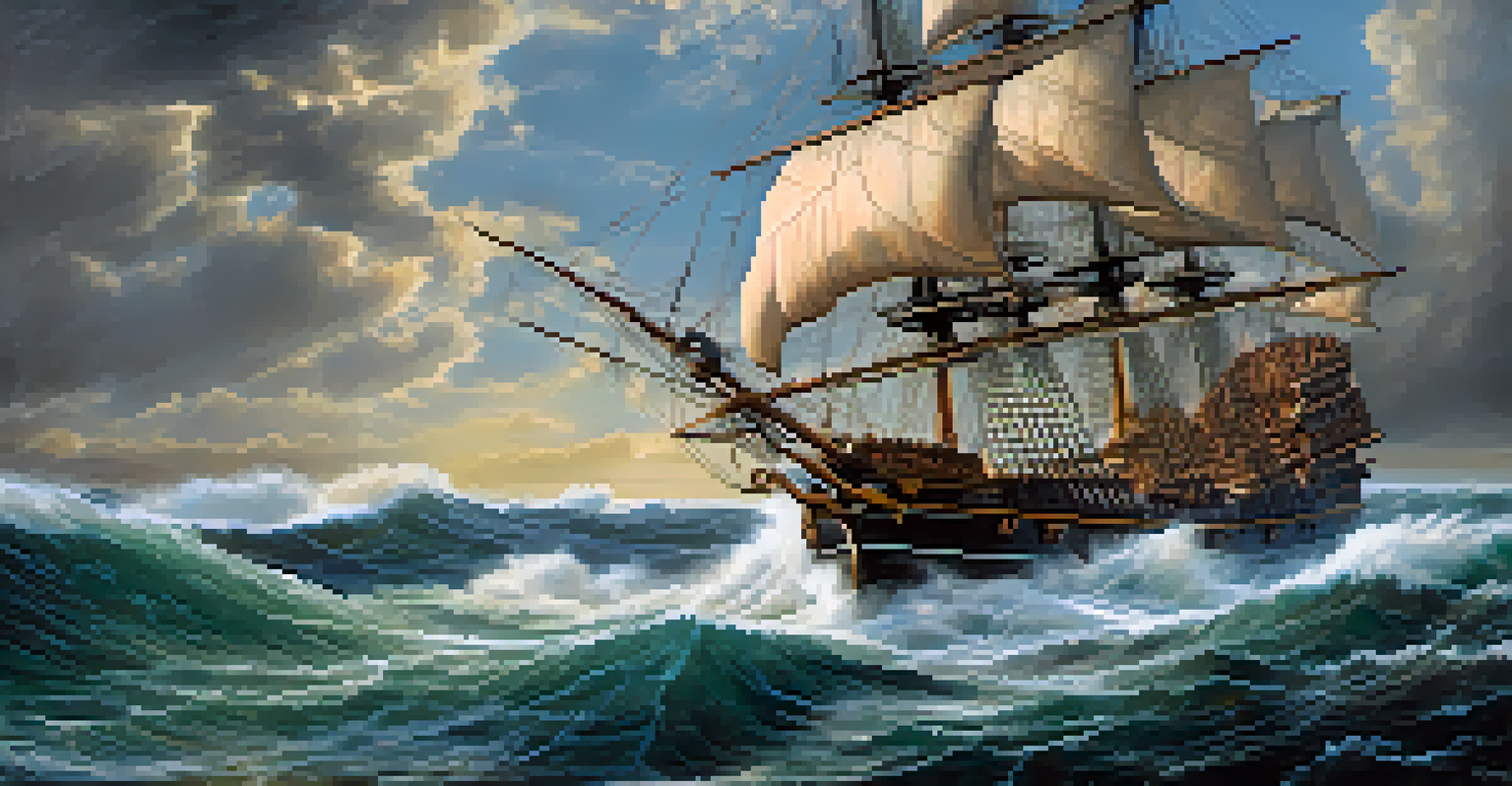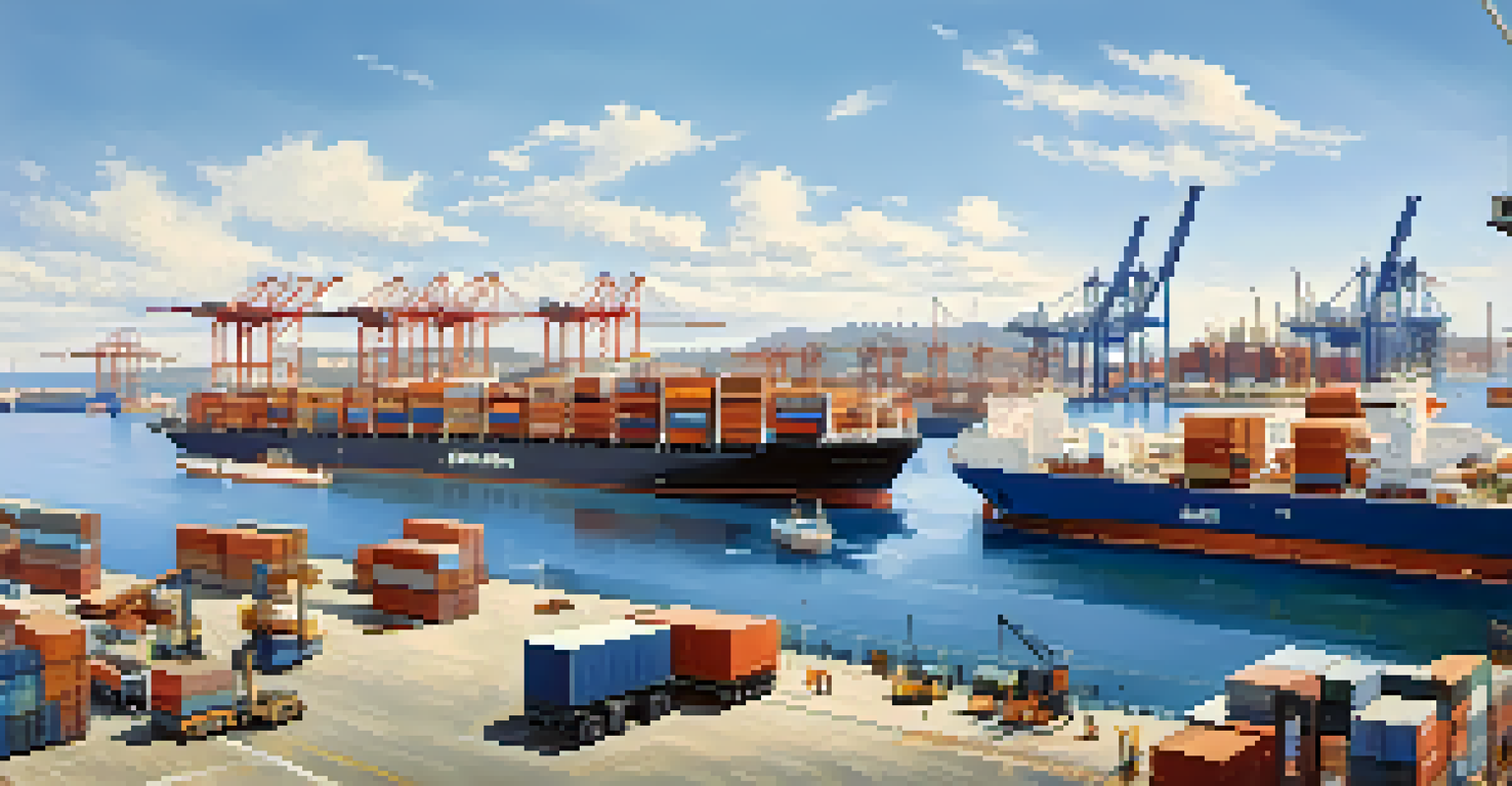The Evolution of Spanish Maritime Navigation: A Historical Overview

Early Maritime Traditions of the Iberian Peninsula
Long before Spain became a maritime powerhouse, the Iberian Peninsula boasted a rich tradition of seafaring. Ancient tribes like the Phoenicians and Greeks established trade routes along the coasts, laying the groundwork for future maritime exploration. These early navigators utilized simple boats and relied on the stars and coastal landmarks for navigation, showing an innate understanding of the sea's rhythms.
The sea is dangerous and its storms terrible, but these obstacles have never been sufficient reason to remain ashore.
As these civilizations thrived, they exchanged goods, culture, and knowledge with various peoples across the Mediterranean. This exchange not only enhanced maritime skills but also introduced new technologies, such as advanced shipbuilding techniques. The foundation for Spain's future maritime endeavors was steadily being built, with early mariners setting the stage for more ambitious voyages.
By the time the Romans arrived, they recognized the strategic importance of the region's maritime activities. They expanded existing ports and established new ones, promoting trade throughout the Mediterranean. This period marked a significant evolution in maritime navigation, as the Romans introduced more sophisticated navigation tools and methods, further enriching the Iberian seafaring tradition.
The Age of Exploration: Spain's Golden Era at Sea
The 15th century marked a turning point in Spanish maritime navigation, heralding the Age of Exploration. With the unification of Spain under Ferdinand and Isabella, the country set its sights on overseas expansion. Christopher Columbus's historic voyage in 1492, funded by the Spanish crown, opened the floodgates for exploration, leading to the discovery of the New World.

During this period, Spanish navigators refined their skills and developed innovative ships like the caravel, which featured a lateen sail for better maneuverability. These advancements allowed for longer voyages and greater exploration of uncharted waters. The Spanish Empire quickly established trade routes across the Atlantic, expanding its influence and wealth.
Iberian Peninsula's Early Seafaring
Ancient tribes like the Phoenicians and Greeks laid the foundation for Spain's maritime tradition through trade and navigation.
However, this era was not without challenges. Navigators faced treacherous waters, unknown territories, and the ever-present threat of storms. Yet, their determination to chart new courses and establish colonies propelled Spain to the forefront of maritime power, influencing global trade and politics for centuries.
Technological Innovations in Spanish Navigation
As the demand for exploration grew, so did the need for technological advancements in navigation. Spanish mariners began to adopt and adapt various navigational tools, including the astrolabe and quadrant, which allowed for more precise measurements of latitude. These tools were crucial for sailors as they navigated the vast and often unpredictable oceans.
In every work of art the spirit of the age must be reflected, as well as the spirit of the people who have lived in that age.
In addition to tools, ship design underwent significant changes during this time. The introduction of the galleon, a larger and more stable vessel, revolutionized maritime travel. These ships were not only capable of carrying larger cargo loads but also better equipped to withstand harsh ocean conditions, making them ideal for long-distance voyages.
These innovations were instrumental in maintaining Spain's dominance at sea. The combination of improved ships and navigational tools allowed Spanish explorers to venture further and more confidently into the unknown, facilitating the establishment of colonies and trade networks that would reshape the world.
The Role of the Spanish Armada in Naval Power
The Spanish Armada was a formidable fleet that played a crucial role in establishing Spain's naval supremacy during the late 16th century. Comprised of over 130 ships, the Armada was initially assembled to invade England and restore Catholic rule. However, the mission highlighted both the strengths and vulnerabilities of Spanish naval power.
Despite its vast size and impressive firepower, the Armada faced challenges that ultimately led to its downfall. Poor planning, lack of coordination, and adverse weather conditions contributed to its defeat in 1588. This loss was not just a military setback; it also marked a turning point in the balance of naval power in Europe, signaling the rise of other maritime nations.
Spain's Age of Exploration
The 15th century marked Spain's rise as a maritime power, driven by Columbus's voyage and advancements in ship design.
The legacy of the Spanish Armada endures, serving as a reminder of the complexities of naval warfare and the importance of strategic planning. While the defeat was significant, the Armada's existence underscored Spain's maritime ambitions and its willingness to invest in naval power to protect and expand its empire.
Spanish Maritime Trade and Its Global Impact
Throughout the 16th and 17th centuries, Spain's maritime navigation facilitated extensive trade networks that spanned the globe. The establishment of the Manila Galleons created a vital trade route between the Philippines and Mexico, allowing for the exchange of goods like spices, silk, and precious metals. This trade significantly boosted the Spanish economy and influenced global commerce.
Spanish ships became synonymous with the exchange of culture and goods, fostering connections between distant lands. The influx of wealth from the Americas transformed Spain into one of the world's leading powers, allowing it to exert influence across Europe and beyond. However, this wealth also attracted competition and conflict with other emerging maritime nations.
The global impact of Spanish maritime trade is felt to this day, as it laid the foundations for modern globalization. The exchange of ideas, cultures, and products during this period reshaped societies and economies, demonstrating how maritime navigation can connect people across vast distances.
Decline of Spanish Maritime Power in the 18th Century
As the 18th century unfolded, Spain's maritime dominance began to wane due to various internal and external factors. Economic challenges, military defeats, and the rise of rival powers like England and France contributed to this decline. The loss of key territories in the Americas further weakened Spain's once-mighty naval capabilities.
Additionally, the emergence of new navigational techniques and technologies by rival nations made it increasingly difficult for Spain to maintain its edge at sea. As other countries invested in their naval fleets, Spain struggled to keep pace, leading to a gradual loss of influence and control over its maritime routes.
Modern Maritime Innovations
Today, Spain integrates advanced technology and sustainable practices, positioning itself as a key player in global maritime trade.
This decline marked a significant shift in the global balance of power. While Spain's maritime legacy remained influential, the changing tides of history signaled the end of its era as a dominant force in maritime navigation, paving the way for new players to emerge on the world stage.
Modern Spanish Maritime Navigation: A New Era
In contemporary times, Spain has seen a resurgence in its maritime activities, driven by advances in technology and a renewed focus on sustainability. The country's strategic location along major shipping routes has made it a hub for maritime trade and tourism, attracting global attention. Spanish ports have been modernized to accommodate larger vessels and improve efficiency.
Additionally, Spain has embraced innovations such as eco-friendly shipping practices and digital navigation tools. These advancements not only enhance operational effectiveness but also reflect a commitment to environmental responsibility. The emphasis on sustainable maritime practices aligns with global efforts to combat climate change and ensures the long-term viability of the industry.

Today, Spain stands as a significant player in the maritime sector, balancing its rich historical heritage with modern innovations. The evolution of Spanish maritime navigation serves as a testament to the country's resilience and adaptability, showcasing its ability to navigate the changing tides of history while looking forward to a sustainable future.